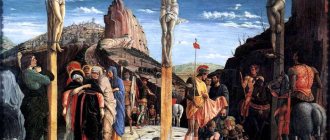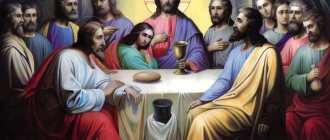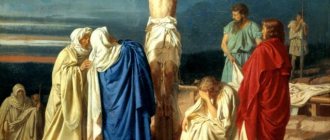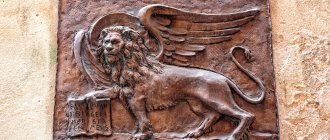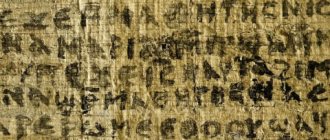The religion that created the civilization of Europe, which determined the cultural identity of Russia, is a kind of pinnacle, when everything possible has already been said about man and his salvation. This is Christianity - a world religion, first among others in terms of the number of followers. The article very briefly and popularly outlines the entire history of Christianity from its inception to the present day.
Where, when and why did Christianity originate?
The place where the first Christians appeared was Palestine, the “Promised Land,” according to the Bible, promised to the “chosen people” of the Jews by God Himself.
Interesting fact
It is significant: Christianity appeared precisely when the Jewish state, which had lost its independence, became part of the Roman Empire.
Covering almost the entire civilized world of that time, it became the environment where the teaching that arose in Judea became global. And by the end of the Apostolic Age, Christianity spread to the territories adjacent to the empire, where the Slavs, Scythians, Goths lived...
The beginning of the existence of the Christian church is approximately dated back to the year 33 after the Nativity of Jesus Christ, when, after the Resurrection and Ascension of the Savior, the community of His disciples received the gift of the Holy Spirit, which remains in it to this day.
The emergence of Christianity completes the long spiritual journey not only of the Jewish people, but of all humanity, which began with the Fall of Adam, expulsion from Paradise, when man lost contact with his Creator. But the Lord says in the words of the prophet Isaiah:
“Will a woman forget her suckling child, so as not to have compassion on the son of her womb? but even if she forgot, I will not forget you.”
(Isa. 49:15).
Fulfilling this promise, the Lord comes to earth to save everyone who is ready to trust Him. The world was waiting - but only the Jews, who knew the promise of the Savior given by God to the first people after their expulsion from Paradise, knew what exactly. Or rather, Who.
The Expulsion of Adam and Eve from Paradise, Gustave Doré
Founder
By the time of His Nativity, the “seventy weeks,” to which the Prophet Daniel testified by the Spirit, had been fulfilled. The Jewish world was waiting for the Messiah. He seemed to people as a great earthly king who would free the chosen people from slavery to pagan Rome.
The words of the prophets began to be fulfilled:
- exactly what was said by Isaiah came true: “Behold, the Virgin shall be with child and give birth to a Son” (Is. 7:14), the Mother of the Founder of Christianity became the pure Virgin, Mary, who grew up at the Temple of Jerusalem, who took a vow of virginity to God; the already elderly Joseph, only an imaginary husband, became the keeper of her promise;
- both the Mother and the imaginary father of Jesus belonged, as the prophets predicted, to the “house and family of David,” and yet the Messiah was supposed to be the “son of David,” that is, his descendant;
- the inhabitants of Nazareth, Joseph and Mary, on the eve of the Nativity of the Son of God found themselves in Bethlehem, the “city of David,” due to the census being carried out by the Roman authorities; Thus, the words about the birth of the Messiah came true here.
However, all these details of the fulfilled prophecies were noticed much later. The event that took place was not immediately realized: people who were expecting the great ruler of royal dignity could not think that:
- He will be born into such a poor family that his parents will be able to offer for him the sacrifice required by the Law of Moses, only “two turtle doves or two chicks of doves” (Luke 2:24);
- moreover, he will live in the insignificant town of Nazareth in the Galilee region, where, in the opinion of orthodox Jews, lived uneducated, uneducated people; and the population of the region was mixed, not only Jews were present here, but there were also pagans; hence what St. John the Theologian popularized the opinion: “Can anything good come from Nazareth?”
"Strange Words" of the Sermon
The Divinity of the Teacher, whom the inhabitants of Nazareth knew, perhaps, as a neighbor, Joseph’s assistant in his carpentry craft, was also not obvious to many, but not as a Wonderworker, the Messiah. Even the simple fishermen who believed, whom we now know as the Apostles, throughout the three years that Jesus’ preaching lasted, considered Him “a prophet, mighty in deed and word before God and all the people,” perhaps “the very” promised King of Israel - but not By God. Meanwhile, Jesus, without hesitation, called Himself the Son of God - so one day many followers simply abandoned Him, saying:
“What strange words! Who can listen to this?
Crucifixion and Resurrection
Finally, the Jews, disappointed with the “Tsar” who still did not begin the long-awaited task of liberation from the hated pagan yoke, replaced admiration for the miracles of the “Rabbi” with hatred. Even among close disciples there was a traitor - Judas, who cherished the dream of becoming a close associate of the King, but remained “just” the “treasurer” of the impoverished community of followers of Jesus Christ.
N. N. Ge “What is truth?” Christ and Pilate. 1890 Oil on canvas. 233 × 171 cm State Tretyakov Gallery, Moscow
By betraying Him to the high priests, he thereby doomed the Teacher to death. It was clear that the Jews, angry at the “strange words” and the fact that Jesus “being a man, makes himself God” (John 10:33), would ask the Roman authorities for execution. And so it happened. The disciples of Christ fled, their brotherhood seemed to have dissipated, and their hopes were in ruins.
What happened next was not only unexpected, but also incomprehensible. On the third day, the Body of Christ was not found in the sealed cave that served as His tomb. And then many saw His disciples - once fearful, now bold preachers, until recently sad, despondent - now carrying strange, unprecedented news: Christ has risen! These words became the banner of the young Church, perhaps its first Creed. They are said to have been used to greet the Roman Emperor himself. Mary Magdalene, the first to personally see the Risen One.
And according to the words of the Apostle Paul, “if Christ has not been raised, our preaching is in vain, and so is our faith” (1 Cor.:15:14).
And yet, even after the miracle of the Resurrection of the Savior, the recognition of His Divinity, even just before the Ascension of the Lord into heaven, He is still asked:
“Is it not at this time, O Lord, that you are restoring the kingdom to Israel?” (Acts 1:6), that is, is He not still an earthly king?
Another 10 days will pass, and the Holy Spirit Himself, the Third Person of the Holy Trinity, will “pronounce” to the Apostles all the truths of the faith that cannot be understood with the mind. This is how the Church will be born.
Biography - Christianity, philosophy Christianity Books Christianity Works Christianity
Biography
Christianity (from the Greek Χριστός - “anointed one”, “messiah”) is an Abrahamic world religion based on the life and teachings of Jesus Christ, described in the New Testament. Christians believe that Jesus of Nazareth is the Messiah, the Son of God and the Savior of mankind. Christians do not doubt the historicity of Jesus Christ. Christianity is the largest world religion, both in terms of the number of adherents, of which there are about 2.3 billion, and in terms of geographical spread - in every country in the world there is at least one Christian community. The largest movements in Christianity are Catholicism, Orthodoxy and Protestantism. In 1054, the Christian Church split into Western (Catholic) and Eastern (Orthodox). The emergence of Protestantism was the result of the reformation movement in the Catholic Church in the 16th century. Christianity arose in the 1st century in Palestine, which was at that time under the rule of the Roman Empire, initially among the Aramaic-speaking population of Mesopotamia, and already in the first decades of its existence it became widespread in other provinces and among other ethnic groups. Christianity was first adopted as a state religion in Greater Armenia in 301. Under Emperor Constantine I, starting with the edict of 313 on freedom of religion, Christianity began to acquire the status of a state religion in the Roman Empire.
The emergence of Christianity. Christianity originated in the 1st century in Palestine, in the Jewish environment in the context of the messianic movements of Old Testament Judaism. Already in the time of Nero, Christianity was known in many provinces of the Roman Empire. According to the New Testament text of the Acts of the Apostles (Acts 11:26), the noun “Χριστιανοί” - Christians, adherents (or followers) of Christ, first came into use to designate supporters of the new faith in the Syriac-Hellenistic city of Antioch in the 1st century. Initially, Christianity spread among the Jews of Palestine and the Mediterranean diaspora, but already from the first decades, especially thanks to the work of the Apostle Paul, it acquired many followers among other peoples (“pagans”). Until the 5th century, the spread of Christianity occurred mainly within the geographical boundaries of the Roman Empire, as well as in the sphere of its cultural influence (Armenia, eastern Syria, Ethiopia), later (mainly in the 2nd half of the 1st millennium) - among the Germanic and Slavic peoples, later (by the XIII-XIV centuries) - also among the Baltic and Finnish peoples. In modern and recent times, the spread of Christianity outside of Europe occurred due to colonial expansion and the activities of missionaries. Number. Currently, the number of adherents of Christianity around the world is about 2.35 billion, including: in Europe - according to various estimates from 400 to 550 million, in Latin America - about 543 million, in North America - 231 million: USA - 160- 225 million, Canada - 25 million, in Asia - about 350 million, in Africa - 475 million, in Australia and Oceania - 24 million. Approximate number of adherents of various Christian denominations: Catholics - about 1.2 billion, including: about 17 million Catholics of the Eastern Rites; Protestants - according to Britannica, about 420 million (Britannica experts do not include Anglicans (86 million) and independent churches (371 million) in Protestantism), according to the Pew Research Center, which includes Anglicans and the so-called "independent churches" in Protestantism - about 800 million, including: 279 million Pentecostals; about 88 million Anglicans; about 75 million Presbyterians and related denominations; 70 million Methodists; 70 million Baptists; 64 million Lutherans; 16 million Seventh-day Adventists; Orthodox Christians number about 300 million; adherents of the ancient Eastern churches (“non-Chalcedonian” churches and the Assyrian Church of the East) - about 70-80 million, including: followers of the Armenian Apostolic Church - about 9 million.
Today in Christianity there are the following main directions: Catholicism Orthodoxy Protestantism Catholicism Catholic Church Roman Catholic Church Eastern Catholic Churches Old Catholicism Orthodoxy Orthodox Church Autocephalous Orthodox churches Old Believers Priesthood Bespopovostvo Beglopopovostvo Ancient Eastern Orthodoxy Churches that did not accept the confession of faith approved at the Council of Chalcedon in 451 ( IV Ecumenical), are called today ancient Eastern (Oriental) Orthodox or non-Chalcedonian; They do not have Eucharistic communion with the Orthodox churches of the Byzantine tradition. Armenian Apostolic Church Coptic Orthodox Church Ethiopian Orthodox Church Syro-Jacobite Orthodox Church Malankara Orthodox Church Assyrian Church of the East Protestantism Main denominations (more than 10 million church members) Seventh-day Adventists Anglicanism Baptistism Calvinism and Reformation Calvinism Presbyterianism Lutheranism Methodism Pentecostalism Pentecostal denominations Other con Adventist professions Reformists Quakers Mennonites Currents in Protestantism Evangelical Christians Charismatic movements creed Christianity is faith in Christ, the Son of God, our Lord, Savior and Redeemer, this is “the victory that has overcome the world, this is our faith” (I John 5, 4-5) .
Theology. Christianity accepts the Old Testament tradition, dating back to Abraham, of the veneration of one God (monotheism), the creator of the Universe and man. at the same time, the main directions of Christianity introduce into monotheism the idea of the Trinity: three hypostases (God the Father, God the Son, God the Holy Spirit), united in their divine nature. Main features of the Christian religion. monotheism, deepened by the doctrine of the trinity of Hypostases (Persons) in the being of one God. This teaching has given and continues to give rise to philosophical and religious speculation, revealing the depth of its content over the centuries from new and new angles. The concept of God as an absolutely perfect Spirit, not only absolute reason and omnipotence, but also absolute goodness and love (God is love). The doctrine of the absolute value of the human person as an immortal, spiritual being created by God in his own image and likeness, and the doctrine of the equality of all people in their relationship to God: all the same loved by the Heavenly Father, like His children, all destined for an eternal blissful existence in union with God, everyone is given the means to achieve this destiny - free will and divine grace. The doctrine of the ideal purpose of man, which consists in endless, comprehensive, spiritual improvement (“...be perfect, as your Heavenly Father is perfect”) The doctrine of the complete dominance of the spiritual principle over matter: God is the unconditional ruler of matter, as its creator: He has given it to man dominion over the material world in order to realize one’s ideal purpose through the material body and in the material world. Thus, Christianity, dualistic in metaphysics (since it accepts two foreign substances - spirit and matter), is monistic as a religion, for it places matter in unconditional dependence on the spirit, as a creation and medium for the activity of the spirit. Equal distance from both metaphysical and moral materialism and hatred of matter and the material world. Evil is considered to be rooted not in matter, but in the perverted free will of spiritual beings (angels and people), from whom it passes onto matter (“Cursed is the earth for your deeds,” God says to Adam. During creation, everything was “good”). . Annunciation. The doctrine of the resurrection of the flesh and the bliss of the resurrected flesh of the righteous along with their souls in the enlightened, eternal, material world. The doctrine of the God-man - the Eternal Son of God incarnate and made human to save people from sin, curse and death, identified by the Christian church with its founder - Jesus Christ. “God became man so that man might become deified” (St. Athanasius the Great). From this we can see that Christianity strives for harmony of matter and spirit. It does not deny any of the spheres of life, but strives to ennoble them all, considering, however, only the means for man to achieve spiritual, god-like perfection. In addition to the listed features, the Christian religion is characterized by: Essential metaphysical nature of its content. The doctrine of the infallibility of the Church in matters of dogma, due to the Holy Spirit acting in Her at all times. Christology. Christology is the doctrine of Jesus Christ. In Christianity, Jesus is seen as the Messiah predicted by biblical prophecies of the Old Testament. The orthodox (Catholic, Orthodox and Protestant) point of view asserts that Jesus Christ is the God-man - neither half-god nor half-man, but a being who combines in its entirety both divine and human nature, the incarnate Son of God, who existed eternally in Heaven before his birth on Earth, consubstantial with his Father (of the same nature with Him). Arianism considered Jesus Christ to be the perfect creation of God, created before the world. Nestorianism separated the divine nature of the Logos and the human nature of Jesus. Monophysitism, on the contrary, speaks of the absorption of the human nature of Jesus into the divine nature of the Logos. Christian anthropology. According to Christian doctrine, man is created in the image and likeness of God. He was perfect from the beginning, but fell due to the Fall. Fallen man has a rough, visible body, a soul filled with passions and a spirit directed towards God. Meanwhile, man is one, therefore not only the soul, but the whole man, including the body, is subject to salvation (resurrection and deification). The perfect man, inextricably united with the divine nature, is Jesus Christ. However, Christianity also implies other forms of posthumous existence: in hell, heaven and purgatory (only for Catholics). The doctrine of the sacraments. Associated with the concept of God’s incomprehensibly high plan for man is the concept of sacrament, alien to other religions, as a completely special action that goes beyond the boundaries of ritual and rite; If rituals symbolically correlate human life with divine existence and thereby guarantee the stability of balance in the world and man, then the sacraments, according to the traditional Christian understanding, actually introduce the divine presence into human life and serve as a guarantee of the future “deification”, a breakthrough of eschatological time. The most important of the sacraments, recognized by all religions, are baptism (initiation, introducing into Christian life and symbolizing union with God, repentance) and the Eucharist, or communion (eating bread and wine, according to church faith, invisibly transubstantiated into the body and blood of Christ for the sake of the essential union of the believer with Christ, so that Christ “lives in him”). Orthodoxy and Catholicism recognize 5 more sacraments, the sacramental status of which is denied by Protestantism: anointing, which aims to impart to the believer the mystical gifts of the Holy Spirit and, as it were, crowning Baptism; repentance (confession to God in the presence of a priest and absolution); ordination or ordination (ordination to the clergy, which gives not only the authority to teach and “pastorally” lead the faithful, but also, in contrast to the purely legal status of a rabbi in Judaism or a mullah in Islam, primarily the authority to perform the sacraments); marriage, understood as participation in the mystical marriage of Christ and the church (Eph. 5:22,5:32); Unction (accompanied by prayers, anointing the sick body with oil). The concept of a sacrament, always bodily concrete, and the ethics of asceticism are subordinated in Christianity to the idea of the high purpose of all human nature, including the bodily principle, which must be prepared for eschatological enlightenment by both asceticism and the action of the sacraments.
Pre-Nicene period (I - early IV century). Apostolic Age The first century is usually called the Apostolic Century. According to legend, for 12 years after Pentecost, the apostles remained in the vicinity of Jerusalem, and then went to preach worldwide. With the reign of Nero, a period of persecution begins. The last apostle John the theologian dies ca. 100, and with it the apostolic age ends. the time of early Christianity I-II centuries. marked by the activity of the so-called. “Apostolic men,” that is, early Christian writers who were disciples of the apostles themselves. “Apologists” Apostolic men were a transitional group from the apostles themselves to the so-called. apologists. apology (from ancient Greek ἀπολογία - justification) is a word of intercession directed to the persecuting emperors. Justifying Christianity as a fair and reasonable religion, apologists, wittingly or unwittingly, translated the truths of faith into the language of reason, and thus Christian theology was born. The first of these apologists-theologians was martyr. Justin Philosopher from Samaria, Platonist philosopher, after his conversion (c. 133) arrived in Rome, where he founded a theological school to fight the Gnostic heretics. Justin the Philosopher died in the persecution of the Emperor. Marcus Aurelius in 166. The pre-Nicene period ended with the largest “Diocletian persecution” in the history of Christianity (302-311), the goal of which was the complete destruction of the Church. However, persecution only contributed to the establishment and spread of Christianity. Christianization of Armenia At the beginning of the 4th century. (traditional date - 301) Greater Armenia became the first country to adopt Christianity as a state religion, which is associated with the names of St. Gregory the Illuminator and the Armenian king Tiridates III the Great. The policy of persecution of Christians by Emperor Diocletian forces the community of ascetic girls to flee from Rome to Armenia. However, the holy virgins were martyred by the Armenian king Tiridates III (then still a pagan). But subsequently, these events contributed to the conversion of his kingdom to Christianity through the preaching of St. Gregory the Illuminator, who baptized Armenia in 301 and became the first bishop of the kingdom. Thus, Armenia became the first Christian state in history.
Division of churches. The reason for the Great Schism of 1054 was a dispute over lands in southern Italy that formally belonged to Byzantium. Having learned that the Greek rite was being crowded out and forgotten there, the Patriarch of Constantinople Michael Cerularius closed all the churches of the Latin rite in Constantinople. At the same time, he demanded that Rome recognize itself as equal in honor as the Ecumenical Patriarch. Leo IX refused him this and soon died. Meanwhile, papal ambassadors led by Cardinal Humbert arrived in Constantinople. The offended patriarch did not accept them, but only presented written denunciations of the Latin rites. Humbert, in turn, accused the patriarch of several heresies, and on July 16, 1054, he arbitrarily declared an anathema to the patriarch and his followers. Michael Cerularius responded with a Council resolution (reproducing all the accusations of Photius in 867) and anathema to the entire embassy. Thus, in terms of genre, it was yet another schism, which was not immediately recognized as the final break between East and West. In reality, the division of churches was a long process that took place over four centuries (from the 9th to the 12th centuries), and its reason was rooted in the increasing diversity of ecclesiological traditions.




